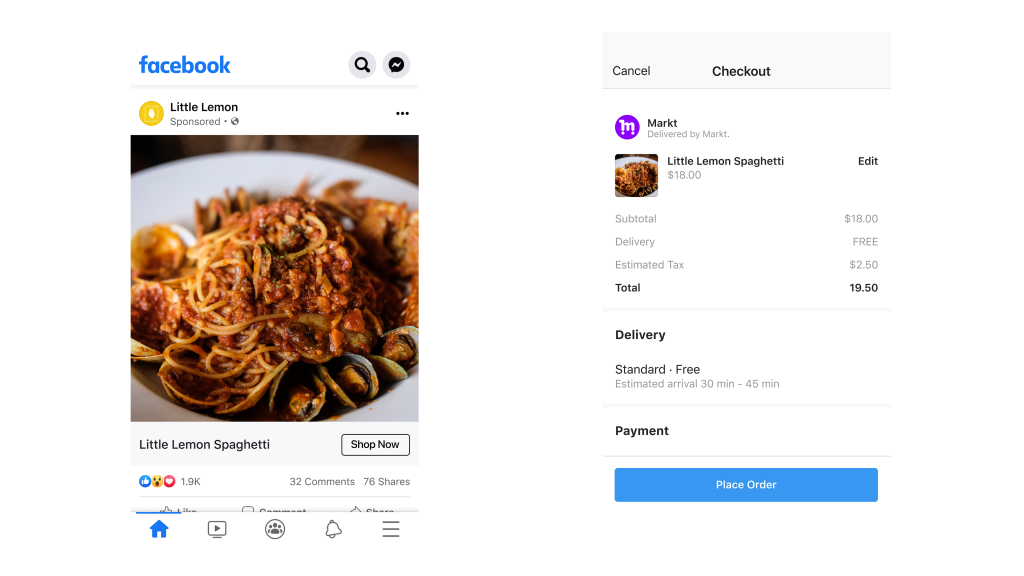Let’s Collab! Meta Reveals New Collaborative Ads
Last Tuesday, Meta revealed their new style of ad; Collaborative Ads for Local Delivery.
This has been released with the intention of creating a smoother purchase journey for consumers; local businesses and CPG brands can now easily promote their products alongside a CTA button which lets people order those same products from their local delivery service. Neat, right?

Why is Meta making this addition?
From the launch of Facebook Marketplace in 2016, Meta has been growing their reach and accessibility, making it easier for brands to target their audiences and for consumers to have a fluid shopping experience. It is only natural that they should want to further fine-tune their marketing strategies for businesses in order continue building their reputation as a competitor in the world of online shopping.
And it’s not hard to understand why they are pursuing this; given the growing trend of social media being used as a shopping platform, it’s important that Meta continues to grow with it. In fact, according to GlobalWebIndex, 54% of people on social media use it to research products, and 71% are more inclined to purchase products based on social media recommendations [Search Engine Watch]. And if people are spending their time researching products on social media, why not make it easier for them to buy that product straight away?
The pandemic is another factor driving e-commerce activity. E-commerce sales were marked at $870 billion in the US in 2021, which is a 50.5% increase since 2019 [Forbes]. Ultimately, the digital economy boomed throughout Covid, with 67% of consumers reporting that their shopping habits changed due to the crisis.[NielsenIQ]. Shopping had to adapt, and e-commerce took the reins. It is safe to say that the use of online shopping – and the influence social media has on it – is only going to grow.
Who does Collaborative Ads for Local Delivery Benefit?
It should benefit everyone! With today’s need for convenience and immediacy, Meta’s Collaborative Ads allow grocery stores and restaurants to meet their customer’s needs directly online – no more waiting around, they can order as soon as they see it! Local delivery is also more time and cost efficient than other forms of shipping, saving both the company and the consumer money. Lower delivery costs? Yes please.
It will also help stores further connect with their local community, building stronger relationships with local customers while also creating a space to target new shoppers. If new consumers know that you are able to provide the items they need at a moment’s notice, then this plays well in your favour. And since Meta has confirmed that they will only show available products with up to date pricing, there’s no fear of something being out of stock after ordering. Which aids the point – customer service sells! Research from Mirakl found that 48% of consumers will reconsider buying from a third-party seller based on negative reviews [My Total Retail], so it is important to maintain a positive reputation and Meta’s reliable stock count will contribute to that.
Eco-friendly commerce is important – will Local Delivery be a positive change?
Environmentally, it should have a positive impact. Local delivery will save businesses from relying on large vehicles or long-haul trailers that guzzle gas (which, as well as its negative effect on the environment, is rocketing in price. Not a great look all round.) Comparatively, local delivery has greener options which don’t empty the pocket of the consumer, such as bikes or e-scooters. There’s no need for long journeys from a warehouse at the opposite end of the country when you can get your produce locally, saving time and finite resources in the process. And since 73% of consumers are willing to change their shopping habits to help the environment [EcoCart], we think this emphasis on local delivery is a great, and feasible, thing.
What does this look like going forward?
It’s in early stages but we think it looks promising. Wendy’s has already demonstrated success using the new collaborative ads in their marketing strategy. Through creating a campaign aimed at reaching consumers who had shown prior engagement with their products on Grubhub, they were able to drive high value conversions.
However, as well as helping to strengthen larger chains, we hope it will bring smaller independent businesses more traffic and recognition, which aligns with a set trend that consumers are looking to shop more locally – again, a factor which was influenced by the pandemic [Speciality Food].
It is also important to remember the prior success of Meta’s launch of collaborative ads for brands and retailers in 2018. For example, the Japanese beauty brand Shu Eumura added collaborative ads to its usual campaign, and saw their sales increase 33%. This growth is fantastic, and hopefully restaurants and grocery stores will receive a similar boost in both sales and community engagement.
Let us know what you think about the new Collaborative Ad release from Meta, and how you might consider using it in your next marketing campaign!
